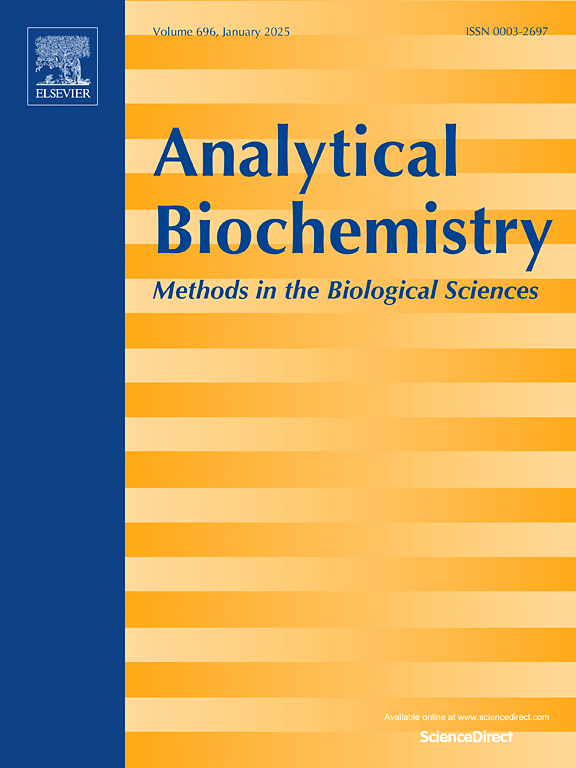High-resolution targeted mass spectrometry for comprehensive quantification of sphingolipids: clinical applications and characterization of extracellular vesicles
IF 2.6
4区 生物学
Q2 BIOCHEMICAL RESEARCH METHODS
引用次数: 0
Abstract
Sphingolipids (SL), a class of membrane lipids, play important roles in numerous biological processes. Their significant structural diversity poses challenges for accurate quantification. To address this, liquid chromatography coupled with tandem mass spectrometry (LC-MS/MS) has emerged as a powerful tool for sphingolipidomics, capable of profiling these lipids comprehensively. In this study, we utilized LC-MS/MS with high-resolution mass spectrometry (MRMHR) to develop a targeted method for the identification and quantification of various SL species. This method, based on validated parameters such as precursor/fragment ions (m/z) and retention time, demonstrated high sensitivity and accuracy, successfully identifying SL species across 12 distinct classes. Its open-panel design also facilitates the analysis of new SL-species targets. Notably, using this approach, we identified 40 SL species in plasma samples from COVID-19 patients, and we determined the influence of matrix metalloproteinase-3 (MMP-3) expression on the positive downstream of SL metabolism. Beyond plasma analysis, this method has potential applications in other biomedical contexts, such as extracellular vesicles (EVs), describing the cargo of sphingosine-1-phosphate (S1P) on macrophage-derived EVs. The establishment of this targeted workflow enabling precise quantification of a wide range of SL species, holds promise for identifying novel biomarkers and therapeutic targets.

高分辨率靶向质谱法用于鞘脂的全面定量:临床应用和细胞外囊泡的表征。
鞘脂(鞘脂)是一类膜脂,在许多生物过程中起着重要作用。它们显著的结构多样性给准确量化带来了挑战。为了解决这个问题,液相色谱联用串联质谱(LC-MS/MS)已经成为鞘脂组学的有力工具,能够全面分析这些脂质。在本研究中,我们利用LC-MS/MS +高分辨率质谱(MRMHR)技术建立了一种针对多种SL物种的鉴定和定量方法。该方法基于前体/碎片离子(m/z)和保留时间等验证参数,具有较高的灵敏度和准确性,成功地鉴定了12个不同类别的SL物种。它的开放式面板设计也有助于分析新的sl物种目标。值得注意的是,利用这种方法,我们在COVID-19患者的血浆样本中鉴定了40种SL,并确定了基质金属蛋白酶-3 (matrix metalloproteinase-3, MMP-3)表达对SL代谢阳性下游的影响。除了血浆分析之外,该方法在其他生物医学领域也有潜在的应用,例如描述巨噬细胞衍生的囊泡上的鞘氨醇-1-磷酸(S1P)货物的细胞外囊泡(ev)。这种有针对性的工作流程的建立能够精确量化广泛的SL物种,为识别新的生物标志物和治疗靶点提供了希望。
本文章由计算机程序翻译,如有差异,请以英文原文为准。
求助全文
约1分钟内获得全文
求助全文
来源期刊

Analytical biochemistry
生物-分析化学
CiteScore
5.70
自引率
0.00%
发文量
283
审稿时长
44 days
期刊介绍:
The journal''s title Analytical Biochemistry: Methods in the Biological Sciences declares its broad scope: methods for the basic biological sciences that include biochemistry, molecular genetics, cell biology, proteomics, immunology, bioinformatics and wherever the frontiers of research take the field.
The emphasis is on methods from the strictly analytical to the more preparative that would include novel approaches to protein purification as well as improvements in cell and organ culture. The actual techniques are equally inclusive ranging from aptamers to zymology.
The journal has been particularly active in:
-Analytical techniques for biological molecules-
Aptamer selection and utilization-
Biosensors-
Chromatography-
Cloning, sequencing and mutagenesis-
Electrochemical methods-
Electrophoresis-
Enzyme characterization methods-
Immunological approaches-
Mass spectrometry of proteins and nucleic acids-
Metabolomics-
Nano level techniques-
Optical spectroscopy in all its forms.
The journal is reluctant to include most drug and strictly clinical studies as there are more suitable publication platforms for these types of papers.
 求助内容:
求助内容: 应助结果提醒方式:
应助结果提醒方式:


